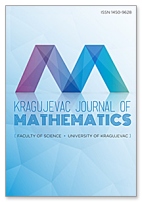A Generalized Class of Close-to-Convex Functions
 Download PDF
Download PDF
Authors: P. KAUR AND S. S. BILLING
DOI: 10.46793/KgJMat2004.533K
Abstract:
Let ℋαϕ(β) denote the class of functions f, analytic in the open unit disk ???? which satisfy the condition

where α, β are pre-assigned real numbers and ϕ(z) is a starlike function. The special cases of the class ℋαϕ(β) have been studied in literature by different authors. In 2007, Singh et al. [?] studied the class ℋαz(β) and they established that functions in ℋαz(β) are univalent for all real numbers α, β satisfying the condition α ≤ β < 1 and the result is sharp in the sense that constant β cannot be replaced by a real number smaller than α. Singh et al. [?] in 2005, proved that for 0 < α < 1 functions in class ℋαz(α) are univalent. In 1975, Al-Amiri and Reade [?] showed that functions in class ℋαz(0) are univalent for all α ≤ 0 and also for α = 1 in ????. In the present paper, we prove that members of the class ℋαϕ(β) are close-to-convex and hence univalent for real numbers α, β and for a starlike function ϕ satisfying the condition β + α − 1 < αℜ ≤ β < 1.
≤ β < 1.
Keywords:
Analytic function, univalent function, close-to-convex function
References:
[1] O. P. Ahuja and H. Silverman, Classes of functions whose derivatives have positive real part, J. Math. Anal. Appl. 138(2) (1989), 385–392.
[2] H. S. Al-Amiri and M. O. Reade, On a linear combination of some expressions in the theory of univalent functions, Monatshefto für Mathematik 80 (1975), 257–264.
[3] S. S. Miller, Differential inequalities and Carathéodory functions, Bull. Amer. Math. Soc. 81 (1975), 79–81.
[4] K. Noshiro, On the theory of schlicht functions, Journal of the Faculty of Science, Hokkaido University 2(3) (1934), 129–155.
[5] S. Singh, S. Gupta and S. Singh, On a problem of univalence of functions satisfying a differential inequality, Math. Inequal. Appl. 10(1) (2007), 95–98.
[6] S. Singh, S. Gupta and S. Singh, On a problem in the theory of univalent functions, General Mathematics 17(3) (2009), 135–139.
[7] V. Singh, S. Singh and S. Gupta, A problem in the theory of univalent functions, Integral Transforms Spec. Funct. 16(2) (2005), 179–186.
[8] S. E. Warchawski, On the higher derivatives at the boundary in conformal mappings, Trans. Amer. Math. Soc. 38 (1935), 310–340.
